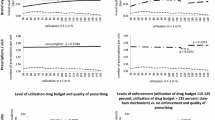Abstract
In Västerbotten County, Sweden, there are two health centers which (in contrast to all other health centers in the region) bear strict responsibility over their pharmaceutical budget. This study examined whether the prices and quantities of pharmaceuticals prescribed by physicians working at these health centers differ significantly from those prescribed by physicians at health centers with open-ended budgets. Estimation results using matching methods, which allows us to compare similar patients at the different health centers, show that the introduction of fixed pharmaceutical budgets did not affect physicians’ prescription behavior, indicating that fixed budgets may not be an efficient measure to reduce costs. Another explanation is that the health centers under study already had taken measures to contain costs, making it hard to further reduce costs.

Similar content being viewed by others
References
Coscelli A (2000) The importance of doctors’ and patients’ preferences in prescription drug markets. J Indust Econ 48:349–369
Dukes MND (ed) (1993) Drug utilization studies. World Health Organization: Copenhagen
Heckman J, Ichimura H, Todd P (1997) Matching as an econometric evaluation estimator: evidence from evaluating a job training program. Rev Econ Stud 64:605–654
Kornai J, Maskin E, Roland G (2003) Understanding the soft budget constraint. J Econ Literature 41:1095–1136
Lundin D (2000) Moral hazard in physician prescription behavior. J Health Econ 19:639–662
Mossialos E, Le Grand J (1999) Cost containment in the EU: an overview. In: Mossialos E, Le Grand J (eds) Health care and cost containment in the European Union. Ashgate
Prendergast C (1999) The provision of incentives in firms. J Econ Literature 37:7–64
Rosenbaum P, Rubin D (1983) The central role of the propensity score in observational studies for causal effects. Biometrica 70:41–55
Rudholm N (2005) Pharmaceutical insurance and the demand for prescription pharmaceuticals in Västerbotten, Sweden. Scand J Public Health 33:50–57
SFS 2002 Lag om läkemedelsförsmåner. 2002:160
Socialstyrelsen (2003) Läkemedelsförsäljningen i Sverige — en analys, Skillnader mellan landsting. 2003:1
Whynes DK, Baines DL, Tolley KH (1997) Prescribing costs in UK general practice: the inpact of hard budget constraints. Appl Econ 29:393–399
Acknowledgements
We are grateful for comments by participants at the Third International Conference on Health Economics, Management and Policy in Athens and by participants at a seminar at Umeå University. We also thank Västerbotten County Council for providing the data and substantial helpful information.
Conflict of interest:
No information supplied
Author information
Authors and Affiliations
Corresponding author
Appendix: balancing tests
Appendix: balancing tests
To guarantee that propensity score matching eliminates all the bias for which the observables can account, the observables must be independent of the treatment assignment conditioned on the propensity score. Several different tests of this condition have been proposed in the literature. These have differing limitations, and little is known about their statistic properties. Our analysis employed two balancing tests. The first was a Hotelling T2 test of the joint null hypothesis of equal means between treatment and control groups. This test can, however, fail to reject the null hypothesis even if X is dependent on treatment assignment, conditioned on the propensity score. One example of this is the case of some variables having higher values in the treated group than in the matched group, for high values of the propensity score but lower values for low values of the propensity score. The second balancing test we conduct is a regression based test described by Smith and Todd (unpublished). For each variable used in estimating the propensity score we estimate the following regression:
where D is an indicator variable which takes the value one if the observation is treated. To test whether D provides additional information about X conditioned on P(X) we tested the joint null hypothesis that all the coefficients of the terms involving D equal 0. A shortcoming to this test is that the choice of the order of the polynomial may affect the result. The results of the tests appear in Table 6. The Hotelling test rejects balance for three of the subsamples for Moröbacke. The results from the regression based test show that between 10% and 33% of the independent variables remain unbalanced conditioned on the propensity score, in all models.
Rights and permissions
About this article
Cite this article
Granlund, D., Rudholm, N. & Wikström, M. Fixed budgets as a cost containment measure for pharmaceuticals. Eur J Health Econ 7, 37–45 (2006). https://doi.org/10.1007/s10198-005-0328-8
Issue Date:
DOI: https://doi.org/10.1007/s10198-005-0328-8




